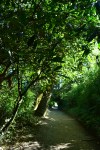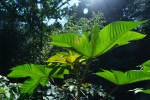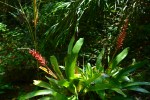Here we are with the fifth visit to my garden journal for 2018, where I report on what is happening in our Avocet garden in Shropshire. Does it show that spring may eventually have arrived?
On my first page for May I wrote, “May began wet with continued patches of cold winds from the East. We continued to garden whenever the rain was not torrential but through it all the garden burgeoned. Fresh greens of every shade brightened our patch and contrasted beautifully with the colours of flowers.”

“The brightest leaves of all are those of ferns, hostas, Jacob’s Ladder and Euphorbia.”






Turning over the page I looked at a job that Ian our gardener completed in May, plus a look at our wildlife in the garden.

“We decided as the first week ended, to clear the greenhouse out and change two soil borders for gravel. Ian, our gardener did the hard work and enjoyed working under cover. The day he did there were intermittent heavy showers and periods of humid sunshine. His waterproof coat was constantly on and off, one minute hanging on his back, the next hanging on a hook in the greenhouse. The soil from the borders became a useful mulch material for nearby borders.”


“Ian cleared the soil away and put membrane down. We covered this in grit.”


“By the end of the first week of May temperatures soared and the rain faded away. Daytime temperatures doubled. The garden has filled with life and as flowers abound, bees, hoverflies and our first butterflies, Orange Tips and Brimstones take to the wing. We garden every day with the constant knocking sound as a Great Spotted Woodpecker bangs away at the finial on top of the wooden telegraph pole opposite our front garden. He hits his own notes!
A woodpecker family nests every year in the old Oak tree in the paddock behind our garden. During the winter several of them visit the feeding stations but once the female is laying and incubating the male makes more frequent visits to our garden feeding himself as well as his partner and the youngsters.
There seem so few Swallows and House Martins wheeling around overhead this year, further signs of a terrible downward trend in population figures. Our Swifts have only just arrived back from their migration so we can look forward to a few months of their squeals overhead.”
Over the page I moved on to look at Dan Pearson’s thoughts on the sudden growth seen in May.

I wrote, “Reading Dan Pearson’s “Natural Selections”, I enjoyed his reference to the noticeably rapid growth in gardens in May.
“The growth is a remarkable thing during these weeks between spring and summer. If you could hear it there would be a tangible hum, made from a million buds breaking and stems flexing. The tide of green sweeps up and over bare earth, cloaking it as fast as the leaves fill out above us.”
For us May is also the month when the first of our visiting garden groups come to share our patch with us. They enjoy wandering around our many paths, taking photographs, asking questions and finishing with tea, coffee and Jude’s home baked cakes.”





I then move on to look at some of our flowering trees and shrubs that are features of our May garden, about which I wrote, “Flowering trees and shrubs add colour and often scent at a higher level than the spring bulbs and early perennials.”
 Viburnum farreri
Viburnum farreri
 Weigela middendorfiana
Weigela middendorfiana


 Cercis siliquastrum
Cercis siliquastrum

Eriostemon Flower Girl White


 Calycanthus floridus Buddleia salvifolia
Calycanthus floridus Buddleia salvifolia
Over the page we look at our Japanese Garden and alpine plants. “We spent more time in mid-May working in the Japanese Garden, where a month ago we added a new step into the lower slope. We planted a miniature Rhododendron at each end of the step. These are now in full flower. Beneath our Prunus subhirtella autumnalis which we have pruned in a Japanese style, we have planted a group of “moss plants”.











On the page opposite are photos of some of our alpines and I wrote, “May is the month when alpine Saxifrages peak.”






“Miniature alpine shrubs, Pinus mugo “Mumpitz” and an alpine Daphne.”


 “Alpine Silene”
“Alpine Silene”
Turning over the page we find the final double page spread, which featured the first Hemerocallis and the first of our roses to flower. On the opposite page blossom was the star.

“The end of May sees the first Hemerocallis coming into flower, and the first of our roses which is a very late start.”







On the final page of my journal for May I featured photos of the fruit blossom which was looking so good and promising a healthy harvest later in the year.
“Fruit blossom this May was the best we can ever remember with apples, pears and quince flowering heavily. We await a great fruit crop!










“Bunches of apples will need thinning out more than ever before!”
So that is the end of my May journal, finishing off on a positive note as the garden feels so full of life.






































































































































































































































































































































































































































